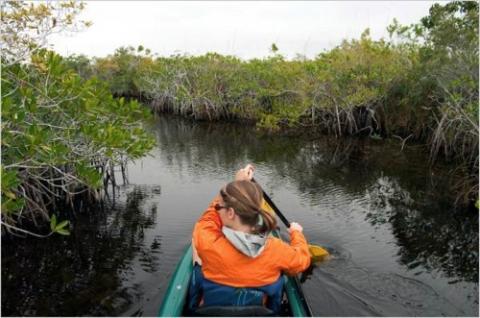I must admit that the only paddling I've done south of the Mason-Dixon Line was on the white-water rivers of West Virginia. The thought of paddling the watery tendrils of Everglades National Park conjures thoughts of swarms of insects that'd keep me swatting the air more than paddling the water. But a recent report by the park on paddling the Nobel Hammock Trail has given me a change of heart.
Contained in See!, a photographic journal published by the park staff, the report creates images of paddling through thick, leafy tunnels of mangroves while craning one's head in search of orchids and bird life.
The Nobel Hammock Trail, a roughly two-mile loop, is one of three water trails you can access off the main road that runs towards Flamingo. If you go to the park's map, you can easily spot the loop. Here's the park's report:
If paddling is one of the most intimate ways to experience natural South Florida, then the canoe trails near Flamingo are one of the best ways to explore Everglades National Park. Right now, it’s a good time of the year to hit the water. The weather is agreeable and there is still plenty of water in the trails, which can become too shallow later in the dry season.
Three canoe trails leave from the main park road about 10 miles from the road’s end at Flamingo. The Hells Bay canoe trail accesses raised wooden platforms, or chickees, for overnight camping. Hells Bay is also the longest trail in the area at 11 miles round trip if you make it all the way to Hells Bay chickee. The Nine-Mile Pond canoe trail, despite its name, is a 5.2 mile round trip. Nine-Mile Pond is a great trail for all skill levels and meanders through both open sections of water and tight mangrove paths. Today, we’ll explore the Noble Hammock canoe trail, the shortest of the three at only 2 miles round trip.
The Noble Hammock Canoe Trail is short in length, but twists so tightly through the mangroves that it makes for a true excursion. The narrow path and the sharp turns will test your steering skills, but the advantage to this trail is that it’s well protected from wind even on blustery days. The entrance to the trail is well marked and roadside parking is available.
On this and other canoe trails, navigation is made simple by a series of orange and white markers that guide you along. The markers keep you from getting lost in the maze of mangroves and come into view just as you’re wondering which way to turn. Also handy are small docks at the entrance and exit of the trail that ease getting into and out of your boat.
One of the nicest features of the Noble Hammock trail is its wide array of plant species. The trail winds through small to medium sized mangroves that are covered in epiphytic bromeliads and orchids. A few of these airplants are locally abundant along the trail, but rare elsewhere in South Florida. The powdery strap airplant, Catopsis bertoniana, can be seen throughout the trail, yet is a State listed endangered species. If careful, you can even spot wormvine orchid, Vanilla barbellata, with thick brown and green roots snaking around a host tree.
The tight nature of the trail requires paddlers to take it slow and this tempered pace makes it the perfect trail for a botanical foray in a unique landscape.
Just when you are beginning to wonder if you passed the hammock without notice, a sign and path beckon your attention. You can glide up to the edge of the hardwood forest and note the sudden change in sights and sounds. The tree island, rumored to be a hideaway for moonshiners in days past, is now a quiet refuge of dry land amongst a sea of mangroves.
Not feeling quite so adventurous? Don’t have your own gear? No problem! Ranger guided canoe tours, with provided boats, paddles and safety equipment are offered everyday until April 4, 2010. Departure times, duration and location vary, and reservations are strongly recommended. For more information, contact the Flamingo Visitor Center at 239-695-2945.


 Support Essential Coverage of Essential Places
Support Essential Coverage of Essential Places







Comments
One more for the list. We kayaked a mangrove trail on Caladesi Island (Gulf coast Florida) last winter. It's amazing how much more observant of tiny things you are (crabs on the mangrove roots, tiny epiphytes) when there's no scenery beyond six feet on either side of you.
At the opposite end of the park (by Everglades City & Chokoloskee), I recommend the Turner River canoe trail for the same type of one-day paddling. It has the advantages of a bit of archeology to go with the birds & plants & fish: there are a couple of shell mounds. And heck, if you have a week, the full wilderness waterway is supposed to be beautiful, although I never had time to do more than a 3 day loop at the north end.
If you go to the Noble Hammock canoe trail or anywhere along the road to Flamingo, make sure to stop and take pictures at the sign for Rock Reef Pass!
My wife and I kayaked the Nine Mile canoe trail this past October. There were a few annoying insects in the parking / launch area, but once we were on the water had no bugs at all. Not much wildlife either, but it was still an excellent paddle. The water is perfectly clear, the trail easy to follow, and the mangrove environment quite interesting. If you have basic canoe / kayak skills, these trails are a wonderful experience.